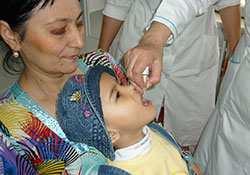Response to the poliomyelitis (polio) outbreak in Tajikistan

WHO/Rahima Mukairshoeva
Tajikistan, which had been polio free since 1996, experienced a massive polio outbreak in 2010 following an importation of poliovirus from northern India. In total, 458 laboratory-confirmed polio cases were reported in 2010 from 35 out of 61 administrative territories of Tajikistan. This outbreak was the first in the WHO European Region since it was certified polio free in 2002, and the biggest in the world since 2005.
The Government of Tajikistan responded quickly to the outbreak and alerted WHO and neighbouring countries. Consultants and special investigation teams were deployed within a few days.
The Ministry of Health – with support from WHO, the United Nations Children's Fund (UNICEF), the United States Agency for International Development (USAID) and other partners – implemented six rounds of national immunization days (NIDs) and one round of subnational immunization days (SNIDs) in 2010. As result, the outbreak was stopped within six months. The last laboratory-confirmed polio case had an onset date of 4 July 2010.
Nevertheless, the country must remain vigilant as long as poliovirus is circulating in neighbouring countries, and seek to regain its polio-free status. For this purpose, Tajikistan should maintain a high level of routine immunization, conduct high-quality immunization campaigns and maintain very sensitive surveillance.
In 2011, as part of the synchronized campaigns conducted in the central Asian countries, Tajikistan conducted a first round of NIDs on 18–22 April. The campaigns included a detailed micro-planning workshop for immunization programme managers at the national and oblast levels, training for health workers and social mobilization activities such as announcements in various media and community meetings. Above all, health workers visited all the households in their catchment areas to ensure high coverage. Several coordination meetings were held between different departments of the Ministry of Health. Vaccine and other equipment were distributed to all health facilities on time. As a result, the campaign was well organized. Different strategies were used to reach the target groups (children aged 5 years and under), including fixed posts at health facilities, mobile teams to seek out hard-to-reach groups and transit teams to reach travelling children.
Government supervision and monitoring found remarkably high coverage, as did partners such as WHO, UNICEF, USAID, Save the Children USA, Mercy Corps, the Red Crescent Society and the Aga Khan Health Services (AKHS). The partners’ joint campaign monitoring showed that overall coverage was 98%. All oblasts achieved more than 95% coverage with oral polio vaccine (OPV). The main reason for missing some children was absence from home during health workers’ visit.



